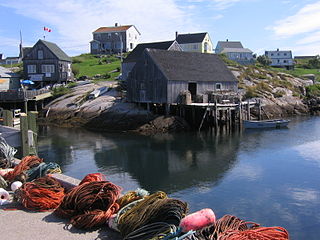
The Maritimes, also called the Maritime provinces, is a region of Eastern Canada consisting of three provinces: New Brunswick, Nova Scotia, and Prince Edward Island. The Maritimes had a population of 1,899,324 in 2021, which makes up 5.1% of Canada's population. Together with Canada's easternmost province, Newfoundland and Labrador, the Maritime provinces make up the region of Atlantic Canada.

Miramichi ( ) is the largest city in northern New Brunswick, Canada. It is situated at the mouth of the Miramichi River where it enters Miramichi Bay. The Miramichi Valley is the second longest valley in New Brunswick, after the Saint John River Valley.

Northumberland County is located in northeastern New Brunswick, Canada.

The Hopewell tradition, also called the Hopewell culture and Hopewellian exchange, describes a network of precontact Native American cultures that flourished in settlements along rivers in the northeastern and midwestern Eastern Woodlands from 100 BCE to 500 CE, in the Middle Woodland period. The Hopewell tradition was not a single culture or society but a widely dispersed set of populations connected by a common network of trade routes.

The Great Serpent Mound is a 1,348-foot-long (411 m), three-foot-high prehistoric effigy mound located in Peebles, Ohio. It was built on what is known as the Serpent Mound crater plateau, running along the Ohio Brush Creek in Adams County, Ohio. The mound is the largest serpent effigy in the world.
Eskɨnuopitijk or Esgenoôpetitj is a Mi'kmaq First Nation band government in New Brunswick, Canada, centred south of the community of Lagacéville and southwest of the village of Neguac on Miramichi Bay. It covers two Indian reserves in Northumberland County and two reserves in Gloucester County (Pabineau). The population was 1,715 as of 2011. The Mi'kmaq call Burnt Church Esgenoôpetitj, which means "a lookout".
William Davidson was a Scottish-Canadian lumber merchant, shipbuilder and politician. He was the first permanent European settler on the Miramichi River in New Brunswick.

The Miramichi Valley is a Canadian river valley and region in the east-central part of New Brunswick. It extends along both major branches of the Miramichi River and their tributaries, however it is generally agreed that the much larger Southwest Miramichi River forms the majority of this region as it is more settled than the Northwest Miramichi River.

The history of New Brunswick covers the period from the arrival of the Paleo-Indians thousands of years ago to the present day. Prior to European colonization, the lands encompassing present-day New Brunswick were inhabited for millennia by the several First Nations groups, most notably the Maliseet, Mi'kmaq, and the Passamaquoddy.
The Eel Ground Band or Eel Ground First Nation is a Mi'kmaq First Nation band government of 977 people located on the Miramichi River in northern New Brunswick, Canada. The community comprises three reserves.
The North Shore is a region in the northeastern part of the Canadian province of New Brunswick.

Beaubears Island is an island at the confluence of the Northwest Miramichi and Southwest Miramichi Rivers near Miramichi, New Brunswick. The island is most famous for being the site of an Acadian refugee camp during the French and Indian War. The camp was under the command of leader of the Acadian resistance to the expulsion, Charles Deschamps de Boishébert et de Raffetot.

Northesk is a civil parish in Northumberland County, New Brunswick, Canada.

Southesk is a civil parish in Northumberland County, New Brunswick, Canada.
Noah Christian Augustine was a former Chief of Metepenagiag Mi'kmaq Nation and prominent native activist in Canada, a founding member of the Native Loggers Business Association, president of the Union of New Brunswick Indians, co-chairman of the Atlantic Policy Congress of First Nations Chiefs and co-founder of the New Brunswick First Nations and Business Liaison Group.
Joseph Michael Augustine was a native leader and historian of the Metepenagiag Mi'kmaq Nation. He discovered the Augustine Mound, which bears his name.
Route 420 is a 35-kilometre (22 mi) long mostly east–west secondary highway in the northwest portion of New Brunswick, Canada.

The Peace and Friendship Treaties were a series of written documents that Britain signed between 1725 and 1779 with various Mi’kmaq, Wolastoqiyik (Maliseet), Abenaki, Penobscot, and Passamaquoddy peoples living in parts of what are now the Maritimes and Gaspé region in Canada and the northeastern United States. Primarily negotiated to reaffirm the peace after periods of war and to facilitate trade, these treaties remain in effect to this day.
Humans have been present in the Canadian Maritime provinces for 10,600 years. In spite of being the first part of Canada to be settled by Europeans, research into the prehistory of the Maritimes did not become extensive until 1969. By the early 1980s, several full-time archaeologists focused on the region.











